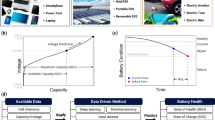Abstract
The feasibility of identifying spent nuclear fuel arising from an unknown fuel cycle in terms of reactor type and burnup using a database of nuclide composition vectors generated for combinations of these two variables is examined. The database and test cases were generated using ORIGEN-ARP, and the concentrations of 200 nuclides were analyzed for each sample. Nearest neighbors and ridge regression techniques were used to make predictions of the reactor type and burnup of test cases. Various truncated nuclide lists were also tested. An initial examination of the techniques’ sensitivity to measurement error was made by perturbing the unknowns’ composition vector and examining the effect on each of the technique’s predictions. We demonstrate through the results of these experiments that investigation and development of multivariate data analysis methodologies for nuclear forensics applications is warranted.



Similar content being viewed by others
References
Join Working Group of the American Physical Society and the American Association for the Advancement of Science (2007), Nuclear Forensics: Role, State of the Art, and Program Needs Science
Moody K, Hutcheon I, Grant P (2005) Nuclear forensic analysis. Taylor and Francis, Boca Raton
Weaver C, Biegalski S, Bucholz B (2009) Assessment of non-traditional isotopic ratios by mass spectrometry for analysis of nuclear activities. J Radioanal Nucl Chem 282:709–713
Whitney S, Biegalski S (2007) Analytical nuclear fuel cycles from isotopic ratios of waste products applicable to measurement by accelerator mass spectrometry. Nucl Sci Eng 157:200–209
Willman C, Hakansson A, Osifo O, Bachlin A, Svard S (2006) Nondestructive assay of spent nuclear fuel with gamma-ray spectroscopy. Anal Nucl Energy 33:427–438
DiFoggio R (1995) Examination of some misconceptions about near-infrared analysis. Appl Spectrosc 49:67–75
Olivieri A (2008) Analytical advantages of multivariate data processing. Anal Chem 80:5713–5720
Beebe K, Pell R, Seasholtz M (1998) Chemometrics: a practical guide. John Wiley and Sons, New York
Hastie T, Tibshirani R, Friedman J (2009) The elements of statistical learning: data mining, inference, and predictions. Springer, New York
Nicolaou G (2008) Identification of unknown irradiated nuclear fuel through its fission product content. J Radioanal Nucl Chem 279:503–508
Ilas G, Gauld I (2006) Analysis of decay heat measurements for BWR fuel assemblies, nuclear fuels, and structural materials for the next generate nuclear reactors. Trans Am Nucl Soc 94:385–387
Knief R (2008) Nuclear engineering: theory and technology of commercial nuclear power. American Nuclear Society, La Grange Park
Murphy B (2004) ORIGEN-ARP cross-section libraries for magnox, advanced gas-cooled, and VVER reactor designs. Oak Ridge National Laboratory, Oak Ridge
England T, Rider B (1994) Evaluation and compilation of fission product yields, LA-UR-94-3106, ENDF-349
Acknowledgments
This research was performed under the Nuclear Forensics Graduate Fellowship Program, which is sponsored by the U.S. Department of Homeland Security, Domestic Nuclear Detection Office and the U.S. Department of Defense, Defense Threat Reduction Agency.
Part of this work was completed under DTRA contract HDTRA1-08-1-0032.
Author information
Authors and Affiliations
Corresponding author
Rights and permissions
About this article
Cite this article
Dayman, K., Biegalski, S. Feasibility of fuel cycle characterization using multiple nuclide signatures. J Radioanal Nucl Chem 296, 195–201 (2013). https://doi.org/10.1007/s10967-012-1987-4
Received:
Published:
Issue Date:
DOI: https://doi.org/10.1007/s10967-012-1987-4




